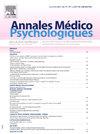以社会心理康复为导向的精神病学日间医院:精神分析的位置是什么?
IF 0.5
4区 医学
Q4 PSYCHIATRY
引用次数: 0
摘要
目的:本文涉及精神分析护理在精神科日间医院的社会心理康复方法中是如何相关的。巴黎第15区精神病日间医院位于GHU巴黎精神病学和神经科学(HDJ),专门照顾成年患者,主要是那些患有精神分裂症和其他严重精神障碍的患者。HDJ成立于20世纪90年代,最初受到精神分析理论的影响,特别是雅克·拉康的理论。然而,在2015年,由于第15区精神病学服务的转型,HDJ经历了重大演变。这导致转向以康复和重新融入社会职业为重点的社会心理康复模式。HDJ将其身份重新定义为康复的过渡空间,强调康复和重新融入社会的重要性。新的护理模式引入了一种结构化的治疗方法,侧重于个性化项目的发展和从护理开始就重新融入专业的机会。护理的概念是基于认知补救、认知行为治疗和精神分析治疗。方法心理社会康复是一套旨在帮助精神障碍患者获得符合其期望的生活质量的过程。它基于一种信念,即每个人都可以朝着个性化的生活项目前进。康复过程包括临床(症状、治疗)、功能(认知能力、人际关系、自主性)和社会(住房、预算管理、就业)等方面。HDJ假定这些原则,并根据多学科团队的临床经验将其纳入护理模式。这个团队包括具有精神分析倾向的临床利益相关者。实际上,经过初步评估,治疗途径现在分为三个阶段:1。稳定和临床巩固:第一个时期包括整个努力达到临床缓解和巩固。重点是确定治疗目标,并指导患者参加满足其特定需求的讲习班。2. 功能康复:一旦克服了急性危机,这一阶段允许评估残余困难并确定患者的优势。3. 康复和重返社会:最后阶段侧重于个性化的认知修复计划,旨在恢复认知缺陷。社工协助与康复、社会融合及就业服务的联系,以支持病人的专业意愿。HDJ强调精神分析在理解患者关系动态方面的重要性。精神分析原则帮助工作人员识别和回应病人无意识的关系模式,加强治疗关系。这种方法营造了一个支持性的环境,病人可以表达他们的个人经历和感受,这是他们康复的两个重要方面。结果本文展示了如何弥合不同护理模式之间的差距,这些模式在直观上可能并不真正兼容。认知补救和认知行为疗法提供的工具,旨在准备病人为就业问题做好准备。精神分析的整合允许深入理解每个病人独特的旅程,承认康复不仅仅是基于症状管理,还基于个人转变和身份重建。该HDJ对个性化护理的承诺显著提高了职业重返社会率,从24%增加到70%,同时也将平均住院时间从69个月减少到17个月,并在HDJ住院结束后两年维持康复项目。在本文中,两个临床案例说明了这种方式发挥综合临床实践,并以患者康复和恢复过程的个性化为特色。结论:该精神科日间医院以护理和康复一体化模式为导向,体现了一种将心理社会康复与精神分析相结合的精神科护理的进步模式。这种双重方法不仅满足了患者的临床需求,而且还支持他们的个人转变和重新融入社会。这些方法相辅相成,促进患者的权力和自决。虽然康复提供了一个护理框架,但精神分析确保护理也解决了个人主观性和无意识问题,从而提高了治疗的整体有效性。本文章由计算机程序翻译,如有差异,请以英文原文为准。
Hôpital de jour de psychiatrie orienté réhabilitation psychosociale : quelle place pour la psychanalyse ?
Objectives
This paper relates how relevant can be a psychoanalytic care intermixed within a psychosocial rehabilitation approach in a psychiatric day hospital. The psychiatric day hospital of the 15th district of Paris at GHU Paris Psychiatrie & Neurosciences (HDJ) specialized in the care of adult patients, primarily those suffering from schizophrenia and other severe mental disorders. Established in the 1990s, the HDJ was initially influenced by psychoanalytic theories, particularly those of Jacques Lacan. However, in 2015, the HDJ underwent a significant evolution due to the transformation of psychiatric services in the 15th district. This led to a shift towards a psychosocial rehabilitation model focused on recovery and social-professional reintegration. The HDJ redefined its identity as a transitional space for recovery, emphasizing the importance of rehabilitation and reintegration into society. The new care model introduced a structured approach to treatment, focusing on the development of individualized projects and the opportunity of professional reintegration from the outset of care. The concept for care is based on cognitive remediation, cognitive behavior therapy and psychoanalytical therapy.
Methods
Psychosocial rehabilitation is defined as a set of processes aimed at helping individuals with mental disorders achieving a satisfying quality of life in accordance to their expectations. It is based on the belief that every person can progress towards a personalized project for life. The rehabilitation process encompasses clinical (symptoms, treatments), functional (cognitive abilities, relationships, autonomy), and social (housing, budget management, employment) dimensions. The HDJ assumed these principles and incorporated them into a model for care, based on the clinical experience of the multidisciplinary team. This team included clinical stakeholders with psychoanalytic orientations. Practically, after an initial assessment, the treatment pathway is now organized into three phases: 1. Stabilization and clinical consolidation: The first period consists in a whole effort to reach clinical remission and consolidation. The focus is on defining treatment goals and directing patients to workshops that address their specific needs. 2. Functional Rehabilitation: Once acute crises have been overcome, this phase allows for the evaluation of residual difficulties and the identification of patient's strengths. 3. Rehabilitation and Reintegration: The final phase focuses on personalized cognitive remediation programs aimed at restoring cognitive deficits. Social workers facilitate connections with rehabilitation, social inclusion and employment services to support patient's professional wishes. The HDJ emphasizes the importance of psychoanalysis in understanding the relational dynamics of patients. Psychoanalytic principles help staff recognize and respond to patient's unconscious relational patterns, enhancing the therapeutic relationship. This approach fosters a supportive environment where patients can express their personal experience and feelings, two essential dimensions for their recovery.
Results
This text shows how to bridge the gap between different models for care which could be intuitively not really compatible. Cognitive remediation and cognitive behavioral therapy provide tools that aims to prepare the patient to be ready for employment issues. The integration of psychoanalysis allows for a deep comprehension of each patient's unique journey, acknowledging that recovery is not merely based on symptom management but also on a personal transformation and on an identity reconstruction. The commitment of this HDJ to individualized care has led to significant improvements in professional reintegration rates, increasing from 24% to 70%, while also reducing the average length of stay from 69 to 17 months with maintain of rehabilitation project two years after the end of hospitalization in the HDJ. In this manuscript, two clinical cases illustrate this way to exert integrative clinical practice and feature the personalization of the course of patients for rehabilitation and recovery.
Conclusion
This psychiatric day hospital oriented toward integrative models for care and recovery exemplifies a progressive model of psychiatric care that combines psychosocial rehabilitation with psychoanalytic insights. This dual approach not only addresses the clinical needs of patients but also supports their personal transformation and reintegration into the social community. These approaches complement each other, promoting patient's empowerment and self-determination. While rehabilitation provides a frame for care, psychoanalysis ensures that care also addresses individual subjectivity and unconscious issues, enhancing the overall effectiveness of the treatment.
求助全文
通过发布文献求助,成功后即可免费获取论文全文。
去求助
来源期刊

Annales medico-psychologiques
医学-精神病学
CiteScore
1.30
自引率
33.30%
发文量
196
审稿时长
4-8 weeks
期刊介绍:
The Annales Médico-Psychologiques is a peer-reviewed medical journal covering the field of psychiatry. Articles are published in French or in English. The journal was established in 1843 and is published by Elsevier on behalf of the Société Médico-Psychologique.
The journal publishes 10 times a year original articles covering biological, genetic, psychological, forensic and cultural issues relevant to the diagnosis and treatment of mental illness, as well as peer reviewed articles that have been presented and discussed during meetings of the Société Médico-Psychologique.To report on the major currents of thought of contemporary psychiatry, and to publish clinical and biological research of international standard, these are the aims of the Annales Médico-Psychologiques.
 求助内容:
求助内容: 应助结果提醒方式:
应助结果提醒方式:


